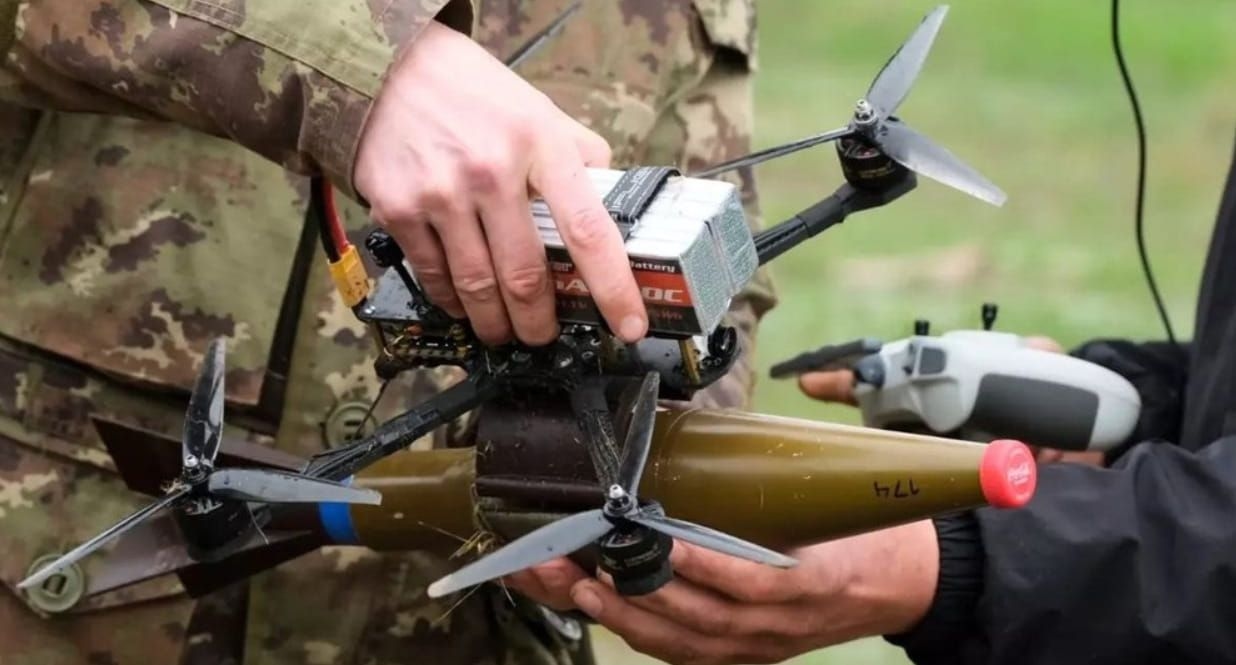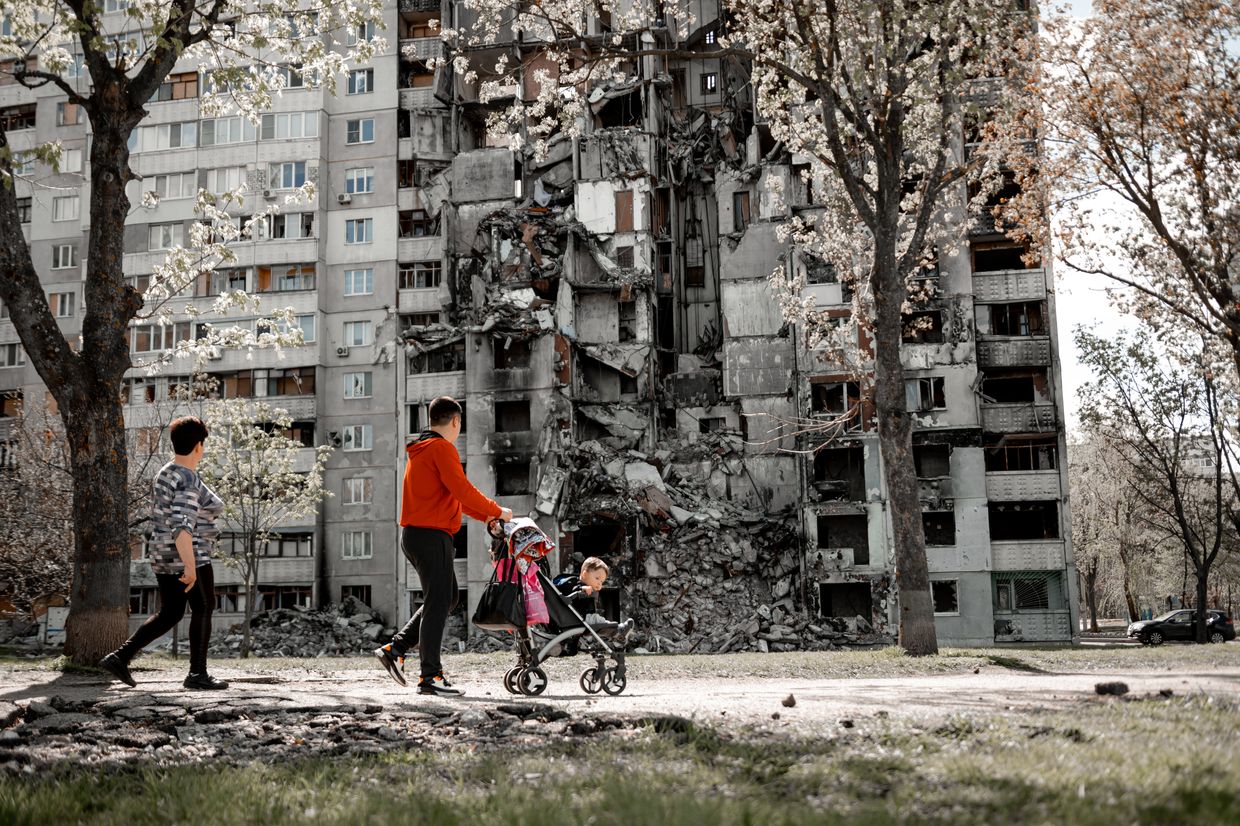
‘Human safari’ – Kherson civilians hunted down by Russian drones
A screenshot of the Russian FPV (first-person view) drone dropping an explosive on the car, allegedly in Kherson Oblast, Ukraine, in an undated video published by a Russian pro-war Telegram channel. (Telegram)
Editor’s note: Some of the Kherson locals interviewed for this story refused to be identified by last name due to fear for their safety.
KHERSON – On a warm September evening, Olha Chernyshova’s day took a grim turn when she was returning home from work in downtown Kherson. Stepping out of her car, she heard a loud buzz and immediately knew it was not a bumblebee.
She rushed towards her home’s entrance door. A deafening blast shook the yard. A drone had dropped an explosive on her car. Time froze.
Back in the yard, Chernyshova saw shattered glass, plastic, and a small metallic cylinder. Her heart racing, she called the police. A team of sappers soon retrieved an undetonated part of a fragmentation grenade. That same day, other drones targeted nearby cars, injuring three of Chernyshova’s neighbors.
A week after the terrifying incident, she spoke to the Kyiv Independent near her home, hiding from another drone under a large chestnut tree.
“Where will we hide once the leaves are gone?” she asked. “It will be an open season on people. I need to work on more drone safety measures.”


Owner of a family grocery store in Kherson, the capital of Ukraine’s southern region on the Dnipro River, Chernyshova lives in a city that has endured relentless Russian artillery and air strikes since its liberation from occupation in the fall of 2022. Local residents last year endured a massive flood triggered by Russia’s blowing up of the Kakhovka dam just north of the city.
Now, like other residents, she finds herself dodging Russian kamikaze drone strikes, typically so-called FPV (first-person view) commercial drones loaded with grenades or other explosives. Their use along the front lines of Russia’s full-scale invasion to kill infantry and tanks alike has been widespread, changing the future of warfare.
But in the ravaged city of Kherson, where Ukraine-controlled territory and Russian forces are separated by the Dnipro River instead of no man’s land between trenches in the eastern Donbas region, civilians are being targeted routinely. Terrified locals refer to the new strategy as “a human safari.”
“Drones are now flying in groups and attacking everything that moves,” said Serhii, a volunteer-turned-taxi driver. “Our charity hub had to close because trucks can no longer deliver humanitarian aid. This has not only cut off critical supplies but also crippled local businesses that rely on transportation. It’s scary to think what will happen in winter when food and fuel shortages could escalate into a full-blown crisis.”
"Drones are now flying in groups and attacking everything that moves."
As drone attacks intensified, Chernyshova — a business owner and mother dedicated to safety — was authorized by the Kherson administration to initiate the development of drone security guidelines for the city. Online public information resource Dovidka.info wrote and designed posters based on her recommendations for Kherson and other front-line zones.
“Drones are a real pain for Kherson. Everyone is a target,” said Oleksandr Prokudin, the head of the Kherson Oblast Military Administration. “Under attack are people walking, driving, bicycling, going to work or standing by grocery stores.”
Drone strikes averaged 100 per day in July and August 2024, he said. But as autumn set in, the numbers have spiked dramatically. Ukraine’s TSN news program reported that a record high of 330 drone strikes and 224 explosive drops hit the region on Sept. 9 alone.
To attack women buying watermelons at city corners and children playing in parks, Russian forces use modified commercial drones.
“First, you see a reconnaissance drone like a Mavic,” said Svitlana, a doctor living by the river.
“You can hardly hear it, and it just looks around, sending video to the Russian pilot across the river,” she said, referring to the eastern bank of the Dnipro River to the south where Russian forces still control swatches of Kherson Oblast.
“Then comes an FPV (first-person view) drone, dropping a grenade on you. Or, a Coca-Cola can with explosives. Sometimes, the drone crashes and blows up. A 90-year-old woman was badly injured next door, in her yard,” she added.
Explosive Ordnance Disposal (EOD) teams respond to drone attacks in Kherson every day.
“Often, as I drive to the location, drones chase my car: they do ‘double taps,’ striking first responders and sappers,” a leading expert in the field told the Kyiv Independent on condition of anonymity citing lack of authority to speak with the media.
"Often, as I drive to the location, drones chase my car: they do ‘double taps,’ striking first responders and sappers."
“I fire at them with an AK rifle, but it’s difficult because the drones are small and fly at an altitude of 120 meters. Any lower than 30 meters means the drone is in attack mode, so I hide and wait. Once it’s gone, I can neutralize an FPV drone or explosives if it hasn't detonated. If it did, I look through debris and, often, human body parts to figure out the kind of drone and explosives used.”
The sapper shared a Telegram channel where Russian drone operators post videos of these attacks.
“They know that the international laws prohibit deliberate attacks on civilians, civilian infrastructure, and humanitarian missions but they believe the anonymity protects them from prosecution,” he said. “They also need to show the results of their work. Russian volunteers fundraise for Mavic and FPV drones because these commercial models lack military certification and aren’t supplied by the military.”
Volodymyr, a former construction business owner, got two concussions as drones dropped explosives on his car four times. He lives in a large house within walking distance of the Dnipro River. He lost his company during the nine months of Russian occupation and survived two years of shelling, bombing, missile attacks, and the Kakhovka dam flood. After two recent artillery attacks, his family left Kherson.

From his window, Volodymyr can see the Dnipro River that divides Ukrainian-controlled territory from the Russian-occupied left bank.
“The river is only 800 meters wide here, and a sniper used to shoot at me from the bushes. When our guys pushed the Russians back last fall, they tried to wipe us out with aerial guided bombs but those were too expensive. So now it’s all drones,” Volodymyr told the Kyiv Independent.
Volodymyr helps a group of volunteers, drone enthusiasts, and local engineers work together to develop anti-drone technologies and assist the Ukrainian military in countering drone attacks.
Another group member, Oleksandr, an engineer and local drone manufacturer involved in the community’s efforts, told the Kyiv Independent that Russian drones can now fly and strike further due to new technology. They are equipped with retransmitters — devices that boost, extend, and share signals between reconnaissance and attack drones.
According to Oleksandr, drones have likely become the weapon of choice due to effective Ukrainian artillery strikes on Russian positions and ammunition depots, potentially causing a shell shortage. This, combined with some Russian troops being redeployed to the Kharkiv and Kursk fronts, has led to a reliance on drones.
“Our Ukrainian military has intercepted Russian phone conversations,” he added. “It seems that graduates of Russian drone pilot schools practice on us, using any moving target for training. They kill and injure civilians every day.”
"It seems that graduates of Russian drone pilot schools practice on us, using any moving target for training."
Angela, a resident of the Shidnyi district, often visits her parents in Antonivka, a town just north of Kherson. There, the main bridge — that once connected both sides of the river – now stands heavily damaged from years of strikes.
Antonivka also faces heavy drone attacks. As Angela waits at a bus stop, drones hover over the street and her heart sinks. She lost Serhii, her husband of 32 years, in early August when shrapnel from a grenade dropped by a drone pierced his heart.
By the time she rushed home from work, Serhii had died. She still lives in their apartment, with drones buzzing by her window daily. With her elderly parents and in-laws still in Kherson Oblast, moving is off the table, due to the financial strain and the logistics.
Close to Angela’s home is the Regional Oncological Health Center. The street in front of it resembles a war movie set, with a minivan abandoned in the middle of the road, its windows broken and doors flung open. A bomb shelter on the corner shows skid marks from an FPV drone that crashed into it.
“Drones attack our buildings, ambulances, and cars daily. They kill our doctors and patients,” said Iryna Sokur, the oncological hospital director. “They also target our generators, putting about 100 patients undergoing chemotherapy or surgery at risk.”
Sadove, another suburb of Kherson, already devasted by incessant artillery attacks, began facing drone attacks in early 2024. By August, residents suffered from ten drone strikes daily, said Natalia, a volunteer.
“One drone destroyed our cell phone tower, so we couldn’t call firefighters,” she said. “The water wells failed because the drones destroyed the diesel generators for pumping water. When the drones dropped napalm on roofs and dried-up lawns, firefighters could not respond due to ‘double taps.’”
As fires destroyed more and more houses in Sadove, most residents were forced to leave even though the evacuation from areas like Antonivka and Sadove diminished or stopped as highways were targeted.
“Everywhere in Kherson, drones drop napalm-filled improvised incendiary devices that explode on impact, causing fires that spread rapidly,” said Volodymyr Perepelytsia, head of explosive services for the National Police in Kherson Oblast. “They also drop banned PFM-1 anti-personnel mines that look like fallen leaves in parks and streets. If you step on them, you lose a limb.”
Until June, the coastal areas of Kherson were targeted the most. By September, drones easily reached downtown.
Ukrainian forces and local authorities are implementing countermeasures against drone attacks. In September 2024, city officials allocated Hr 8 million ($195,000) to enhance defenses.
Since the beginning of the year, over 200 electronic warfare systems have been delivered to troops in Kherson Oblast to strengthen their ability to combat Russian drones. However, the Russian military continually changes frequencies to evade detection by radar and air defense systems, making it challenging for Ukrainian electronic warfare systems to intercept and neutralize them.
Russian drone attacks are likely designed to demoralize Ukrainians, leading to two key outcomes: mass evacuations that create "gray zones" along the Dnipro River and pressure on the Ukrainian government to enter peace talks with the Kremlin.
Since the start of the full-scale Russian invasion, Kherson's population has plummeted from about 280,000 to 60,000, with an additional 50 settlements added to the mandatory evacuation order by August 2024.
The human toll in Kherson is also mounting. Nearly half of the 547 casualties reported from July 1 to Sept. 9, 2024, were caused by drones, according to a representative from the Kherson military administration who spoke on condition of anonymity citing lack of authority to be interviewed by media.
Yet, despite daily attacks, the remaining Kherson residents fix windows with plywood and go on with their lives.
“Life goes on. At my art studio, we have decided to celebrate the forthcoming Kherson City Day with watermelons this Saturday,” said Olena, a medical worker. On Kherson City Day, however, Olena waited for two hours as the drones were hovering over her high rise – they never left and she never made it to the party.















